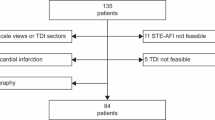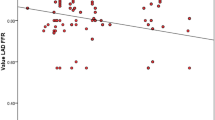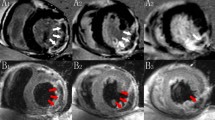Abstract
Background
The benefit of revascularization for functional recovery depends on the presence of viable myocardial tissue.
Objective
Myocardial deformation imaging allows determination of myocardial viability.
Methods
In a first approach, we assessed the optimal cutoff value to determine preserved viability by layer-specific echocardiographic myocardial deformation imaging at rest and low-dose dobutamine (DSE) echocardiography: regional endocardial circumferential strain (eCS) <−19% at rest was as accurate as eCS at DSE. In a main study, 123 patients (66% men, age 59 ± 6 years) with relevant coronary stenoses and corresponding severe regional myocardial dysfunction were included and randomized in 2 groups after coronary angiography: group A: intra-procedural myocardial deformation imaging in the cardiac catheter laboratory (CLab), determination of myocardial viability by regional eCS <−19%, in case of positive viability immediate coronary intervention in the same session. Group B: two-step determination of myocardial viability by cardiovascular magnetic resonance (CMR), in case of positive viability coronary intervention. After 18 months follow-up an analysis of the endpoints regarding cardiovascular events, left ventricular (LV) function, and comparison of cost was performed.
Results
Group A (N = 61) and group B (N = 62) showed no differences concerning localization of the coronary stenosis, comorbidities, or medical therapy. Cardiovascular events at 18-month follow-up were as follows: group A 13% (N = 10) vs. group B 14% (N = 9, p = 0.288); improvement of LV function: group A: +7 ± 2% vs. group B: +7 ± 3%, p = 0.963; costs: group A: 3096 Dollar vs. group B: 6043 Dollar, p < 0.001.
Conclusion
Intra-procedural determination of myocardial viability by myocardial deformation imaging in the CLab is feasible, safe, and cost effective and may become an emerging alternative to the current practice of two-stage viability diagnostics.





Similar content being viewed by others
Change history
02 June 2017
An erratum to this article has been published.
References
Allmann KC, Shaw LJ, Hachamovitvh R et al (2002) Myocardial viability testing and impact of revascularization on prognosis in patients with coronary artery disease and left ventricular dysfunction: a meta-analysis. J Am Coll Cardiol 39:1151–1158
Marwick TH, Zuchowski C, Lauer MS, et al. (1999) Functional status and quality of life in patients with heart failure undergoing coronary bypass surgery after assessment of myocardial viability. J Am Coll Cardiol 33: 750–758
Beller GA (2000) Noninvasive assessment of myocardial viability. N Engl J Med 343:1488–1490
Van Loon RB, Veen G, Baur LH et al (2012) Improved clinical outcome after invasive management of patients with recent myocardial infarction and proven myocardial viability: primary results of a randomized controlled trial (VIAMI-trial). Trials 13:1
Toma A, Gick M, Minners J, Ferenc M, Valina C, Löffelhardt N, Gebhard C, Riede F, Neumann FJ, Buettner HJ (2016 Nov) Survival after percutaneous coronary intervention for chronic total occlusion. Clin Res Cardiol 105(11):921–929
Doenst T, Strüning C, Moschovas A, Gonzalez-Lopez D, Essa Y, Kirov H, Diab M, Faerber G (2016 Oct) Cardiac surgery 2015 reviewed. Clin Res Cardiol 105(10):801–814
Cassese S, Kufner S, Xhepa E, Byrne RA, Kreutzer J, Ibrahim T, Tiroch K, Valgimigli M, Tölg R, Fusaro M, Schunkert H, Laugwitz KL, Mehilli J, Kastrati A (2016 Jul) Three-year efficacy and safety of new- versus early-generation drug-eluting stents for unprotected left main coronary artery disease insights from the ISAR-LEFT MAIN and ISAR-LEFT MAIN 2 trials. Clin Res Cardiol 105(7):575–584
Nijhoff F, Stella PR, Troost MS, Belkacemi A, Nathoe HM, Voskuil M, Samim M, Doevendans PA, Agostoni P (2016 May) Comparative assessment of the antirestenotic efficacy of two paclitaxel drug-eluting balloons with different coatings in the treatment of in-stent restenosis. Clin Res Cardiol 105(5):401–411
Doenst T, Strüning C, Moschovas A, Gonzalez-Lopez D, Valchanov I, Kirov H, Diab M, Faerber G (2015 Dec) Cardiac surgery 2014 reviewed. Clin Res Cardiol 104(12):1006–1020
Härle T, Zeymer U, Hochadel M, Schmidt K, Zahn R, Darius H, Behrens S, Lauer B, Mudra H, Schächinger V, Elsässer A (2015 Oct) Use and impact of thrombectomy in primary percutaneous coronary intervention for acute myocardial infarction with persistent ST-segment elevation: results of the prospective ALKK PCI-registry. Clin Res Cardiol 104(10):803–811
Maurer G, Lee KL, Holly TA et al (2011) Myocardial viability and survival in ischemic left ventricular dysfunction. N Engl J Med 364:1617–1625
Beanlands RS, Nichol G, Huszti E, et al. (2007 Nov 13) F-18-fluorodeoxyglucose positron emission tomography imaging-assisted management of patients with severe left ventricular dysfunction and suspected coronary disease: a randomized, controlled trial (PARR-2). J Am Coll Cardiol. 50:2002–2012.
Cleland JG, Calvert M, Freemantle N et al (2011) The heart failure revascularisation trial (HEART). Eur J Heart Fail 13:227–233
Zeus T, Ketterer U, Leuf D, Dannenberg L, Bönner F, Wagstaff R, Gliem M, Jander S, Kelm M, Polzin A (2016 Apr) Safety of percutaneous coronary intervention in patients with acute ischemic stroke/transient ischemic attack and acute coronary syndrome. Clin Res Cardiol 105(4):356–363
Cassese S, Byrne RA, Ndrepepa G, Schunkert H, Fusaro M, Kastrati A (2015 Oct) Prolonged dual antiplatelet therapy after drug-eluting stenting: meta-analysis of randomized trials. Clin Res Cardiol 104(10):887–901
Shah BN, Khattar RS, Senior R (2013) The hibernating myocardium: current concepts, diagnostic dilemmas, and clinical challenges in the post-STICH era. Eur Heart J 34:1323–1336
Grover S, Srinivasan G, Selvanayagam JB (2012) Myocardial viability imaging: does it still have a role in patient selection prior to coronary revascularization? Heart Lung Circ 21:468–479
Cortigiani L, Bigi R, Sicari R (2012 Mar) Is viability still viable after the STICH trial? Eur Heart J Cardiovasc Imaging 13(3):219–226
Bonzel T, Schächinger V, Dörge H (2016 May) Description of a Heart Team approach to coronary revascularization and its beneficial long-term effect on clinical events after PCI. Clin Res Cardiol 105(5):388–400
Fengler K, Fuernau G, Desch S, Eitel I, Neumann FJ, Olbrich HG, de Waha A, de Waha S, Richardt G, Hennersdorf M, Empen K, Hambrecht R, Fuhrmann J, Böhm M, Poess J, Strasser R, Schneider S, Schuler G, Werdan K, Zeymer U, Thiele H (2015 Jan) Gender differences in patients with cardiogenic shock complicating myocardial infarction: a substudy of the IABP-SHOCK II-trial. Clin Res Cardiol 104(1):71–78
Bestehorn K, Bauer T, Fleck E, Bestehorn M, Pauletzki J, Hamm C (2015 Jul) Coronary procedures in German hospitals: a detailed analysis for specific patient clusters. Clin Res Cardiol 104(7):555–565
Leibundgut G, Gick M, Morel O, Ferenc M, Werner KD, Comberg T, Kienzle RP, Buettner HJ, Neumann FJ (2016 May) Discordant cardiac biomarker levels independently predict outcome in ST-segment elevation myocardial infarction. Clin Res Cardiol 105(5):432–440
Siebelink HM, Blanksma PK, Crijns HJ et al (2001) No difference in cardiac event-free survival between positron emission tomography-guided and single-photon emission computed tomography-guided patient management: a prospective, randomized comparison of patients with suspicion of jeopardized myocardium. J Am Coll Cardiol 37:81–88
de Waha S, Eitel I, Desch S, Fuernau G, Lurz P, Urban D, Schuler G, Thiele H (2015 Sep) Intravenous morphine administration and reperfusion success in ST-elevation myocardial infarction: insights from cardiac magnetic resonance imaging. Clin Res Cardiol 104(9):727–734
Becker M, Füting A, Balzer J et al (2009) Impact of infarct transmurality on layer specific impairment of myocardial function. A myocardial deformation imaging study. Eur Heart J 30:1467–1476
Huttin O, Marie PY, Benichou M, Bozec E, Lemoine S, Mandry D, Juillière Y, Sadoul N, Micard E, Duarte K, Beaumont M, Rossignol P, Girerd N, Selton-Suty C (2016 Oct) Temporal deformation pattern in acute and late phases of ST-elevation myocardial infarction: incremental value of longitudinal post-systolic strain to assess myocardial viability. Clin Res Cardiol 105(10):815–826
Riffel JH, Keller MG, Aurich M, Sander Y, Andre F, Giusca S, Aus dem Siepen F, Seitz S, Galuschky C, Korosoglou G, Mereles D, Katus HA, Buss SJ (2015 Jul) Assessment of global longitudinal strain using standardized myocardial deformation imaging: a modality independent software approach. Clin Res Cardiol 104(7):591–602
Schroeder J, Hamada S, Gründlinger N, Rubeau T, Altiok E, Ulbrich K, Keszei A, Marx N, Becker M (2016 Mar) Myocardial deformation by strain echocardiography identifies patients with acute coronary syndrome and non-diagnostic ECG presenting in a chest pain unit: a prospective study of diagnostic accuracy. Clin Res Cardiol 105(3):248–256
Becker M, Altiok E, Ocklenburg C et al (2011) Layer specific analysis of myocardial function for prediction of reversible ischemic dysfunction in intermediate viability defined by ceMRI. Heart 97:748–756
Karavidas A, Xylomenos G, Matzaraki V, Papoutsidakis N, Leventopoulos G, Farmakis D, Lazaros G, Perpinia A, Arapi S, Paisios N, Parissis J, Pyrgakis V, Gargalianos P (2015 Nov) Myocardial deformation imaging unmasks subtle left ventricular systolic dysfunction in asymptomatic and treatment-naïve HIV patients. Clin Res Cardiol 104(11):975–981
Gong L, Li D, Chen J et al (2013) Assessment of myocardial viability in patients with acute myocardial infarction by two-dimensional speckle tracking echocardiography combined with low-dose dobutamine stress echocardiography. Int J Cardiovasc Imaging 10:1017–1028
Armstrong WF, Pellikka PA, Ryan T et al (1998) Stress echocardiography: recommendations for performance and interpretation of stress echocardiography. Stress Echocardiography Task Force of the Nomenclature and Standards Committee of the American Society of Echocardiography. J Am Soc Echocardiogr 11:97–104
Langeland S, D’hooge J, Wouters PF et al (2005) Experimental validation of a new ultrasound method for the simultaneous assessment of radial and longitudinal myocardial deformation independent of insonation angle. Circulation 112:2157–2162
Bachner-Hinenzon N, Ertracht O, Lysiansky M et al (2011) Layer-specific assessment of left ventricular function by utilizing wavelet de-noising: a validation study. Med Biol Eng Comput 49(1):3–13
Kramer CM, Barkhausen J, Flamm SD, et al. (2013) Standardized cardiovascular magnetic resonance (CMR) protocols 2013 update. J Cardiovasc Magn Reson 15:91
Kim RJ, Wu E, Rafael A et al (2000) The use of contrast-enhanced magnetic resonance imaging to identify reversible myocardial dysfunction. N Engl J Med 343:1445–1453
Bisplinghoff S, Hänisch C, Becker M et al (2015) Fusion of coronary angiography and stress echocardiography for myocardial viability evaluation. Int J Comput Assist Radiol Surg 10:11–17
Picano E (2005) Economic and biological cost of cardiac imaging. Cardiovasc Ultrasound 3:11–13
Blackwelder WC (1982) “Proving the null hypothesis” in clinical trials. Control Clin Trials 3:345–353
Task Force on Myocardial Revascularization of the European Society of Cardiology (ESC), European Association for Cardio-Thoracic Surgery (EACTS), European Association for Cardio-Thoracic Surgery (EACTS) (2010) Guidelines on myocardial revascularization. Eur Heart J 31: 2501–2555
Camici PG, Prasad SK, Rimoldi OE (2008) Stunning, hibernation, and assessment of myocardial viability. Circulation 117:103–114
Bax JJ, van der Wall EE, Harbinson M. (2004 Aug) Radionuclide techniques for the assessment of myocardial viability and hibernation. Heart 90(Suppl 5):v26-v33.
Rizzello V, Poldermans D, Biagini E et al (2009) Prognosis of patients with ischaemic cardiomyopathy after coronary revascularisation: relation to viability and improvement in left ventricular ejection fraction. Heart 95:1273–1277
Vanoverschelde JL, Wijns W, Borgers M et al (1997) Chronic myocardial hibernation in humans. From bedside to bench. Circulation 95:1961–1971
Kwon DH, Halley CM, Carrigan TP et al (2009) Extent of left ventricular scar predicts outcomes in ischemic cardiomyopathy patients with significantly reduced systolic function: a delayed hyperenhancement cardiac magnetic resonance study. JACC Cardiovasc Imaging 2:34–44
Gerber BL, Rousseau MF, Ahn SA et al (2012) Prognostic value of myocardial viability by delayed-enhanced magnetic resonance in patients with coronary artery disease and low ejection fraction. J Am Coll Cardiol 59:825–835
Baer FM, Theissen P, Crnac J et al (2000) Head to head comparison of dobutamine-transoesophageal echocardiography and dobutamine-magnetic resonance imaging for the prediction of left ventricular functional recovery in patients with chronic coronary artery disease. Eur Heart J 21:981–991
SchinkelAF, Bax JJ, Poldermans D et al (2007) Hibernating myocardium: diagnosis and patient outcomes. Curr Probl Cardiol 32:375–410
Hoffmann R, von Bardeleben S, Kasprzak JD et al (2006) Analysis of regional left ventricular function by cineventriculography, cardiac magnetic resonance imaging, and unenhanced and contrast-enhanced echocardiography: a multicenter comparison of methods. J Am Coll Cardiol 47:121–128
Shimoni S, Frangogiannis NG, Aggeli CJ et al (2003) Identification of hibernating myocardium with quantitative intravenous myocardial contrast echocardiography: comparison with dobutamine echocardiography and thallium-201 scintigraphy. Circulation 107:538–544
Bansal M, Jeffriess L, Leano R et al (2010) Assessment of myocardial viability at dobutamine echocardiography by deformation analysis using tissue velocity and speckle tracking. J Am Coll Cardiol Imaging 3:121–131
Ono S, Waldman LK, Yamashita H et al (1995) Effect of coronary artery reperfusion on transmural myocardial remodeling in dogs. Circulation 91:1143–1153
Hsu EW, Muzikant AL, Matulevicius SA, Penland RC, Henriquez CS (1998) Magnetic resonance myocardial fiber-orientation mapping with direct histological correlation. Am J Physiol 274:1627–1634
Kwon DH, Asamoto L, Popovic ZB, Kusunose K, Robinson M, Desai M, et al. (2014) Infarct characterization and quantification by delayed enhancement cardiac magnetic resonance imaging is a powerful independent and incremental predictor of mortality in patients with advanced ischemic cardiomyopathy. Circ Cardiovasc Imaging 7: 796–804.
Vanoverschelde JL, Depré C, Gerber BL et al (2000) Time course of functional recovery after coronary artery bypass graft surgery in patients with chronic left ventricular ischemic dysfunction. Am J Cardiol 85:1432–1439
Beanlands RS, Ruddy TD, deKemp RA et al (2002) Positron emission tomography and recovery following revascularization (PARR-1): the importance of scar and the development of a prediction rule for the degree of recovery of left ventricular function. J Am Coll Cardiol 40:1735–1743
Sciagrà R, Leoncini M, Cannizzaro G et al (2002) Predicting revascularization outcome in patients with coronary artery disease and left ventricular dysfunction (data from the SEMINATOR study). Am J Cardiol 89:1369–1373
Acknowledgements
MB designed the study and managed research process; MB, AS, and VK chaired data acquisition and analysis and interpretation of results; and VK and MB wrote the report. MB, AS, and VK had full access to all of the data in the study and took responsibility for the integrity of the data and the accuracy of the data analysis. Data were analyzed by SH and JS (DSE) and EA (CMR). MDF developed the medical-technical approach of image fusion. AK contributed to statistical interpretation of results. MK and NM contributed to data analysis and interpretation and reviewed the report. NM and SH contributed to the writing of the report.
Funding
The study was granted by the German Research Foundation (BE 4388/1–1, DE 1705/1–1).
Author information
Authors and Affiliations
Corresponding author
Ethics declarations
Conflict of interest
All authors declare no conflicts of interest.
Additional information
Alexander Schuh and Vadim Karayusuf have contributed equally to this work.
An erratum to this article is available at https://doi.org/10.1007/s00392-017-1125-y.
Rights and permissions
About this article
Cite this article
Schuh, A., Karayusuf, V., Altiok, E. et al. Intra-procedural determination of viability by myocardial deformation imaging: a randomized prospective study in the cardiac catheter laboratory. Clin Res Cardiol 106, 629–644 (2017). https://doi.org/10.1007/s00392-017-1099-9
Received:
Accepted:
Published:
Issue Date:
DOI: https://doi.org/10.1007/s00392-017-1099-9




